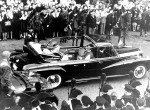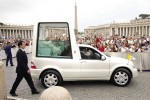- POPE PAUL VI occupied the center seat in this Mercedes-Benz 600 Pullman Landaulet open-top car.
- POPE Paul VI in the Mercedes-Benz 300d upon his return from a pilgrimage that had taken him to the Holy Land and Jordan
- POPE John XXIII being driven to the Italian state president
- POPE JOHN Paul II rides in a popemobile based on the Mercedes G-Class.
- POPE BENEDICT XVI (formerly Cardinal Ratzinger) used a Mercedes ML 430 with modified bodywork. On the Pope’s right is Daimler chair Dieter Zetsche.
- ONE OF the earliest popemobiles was this sedan chair donated by the city of Naples to Leo XIII.
- JOHN Paul II used the Mercedes 300 SEL during his first outing after his election in 1978.
- JOHN Paul II drives through St. Peter’s Square in a Mercedes ML-Class-based popemobile.
- THE NEW popemobile is based on the Philippine jeepney, a symbol of Filipino ingenuity and adaptability. Jason K. Ang
- UNTIL THE early years of the papacy of Pius XI, this black landau carriage was used for nonceromonial occasions.
- THE OPULENT Gran Gala Berlin carriage, a mobile throne room, was built in 1826 for Pope Leo XXII.
- THE MERCEDES-BENZ 600 Pullman Landaulet used by Pope Paul VI
- Pope went to a devastated Roman neighborhood after an American bombing.
- THE ARMORED Mercedes 500 SEL used by John Paul II. The shield is to protect against wind, not bullets.
- PRESTO, ADAGIO The lettering on the control panel used by the Pope to convey instructions to his driver reads like an opera score.
- POPE PIUS XI used a 1930 Nurburg 460 Pullman, the first Mercedes-Benz popemobile.
THE POPE is the leader of the Roman Catholic Church, and he is also the head of his own state, the Vatican. So it’s no surprise that various popes have historically ridden like royalty—something that Pope Francis has made a U-turn from.
Popes in the middle ages rode in sedan chairs. One example was donated by the city of Naples to Leo XIII. Then came horse-drawn carriages, such as a black one used for in the papacy of Pius XI. The opulence came to a high point with the Gran Gala Berlin carriage, a mobile throne room built in 1826 for Pope Leo XXII.
In 1909, Pope Pius X was initially reluctant to use a horseless carriage, but eventually the automobile became the papal conveyance of choice, too. Popes rode Italian cars like the Bianchi Tipo 15 and 20, the Fiat 525, and the Citroen C6.
In 1928, Daimler-Benz supplied a Nurburg limousine, chosen for a modern lower frame versus other variants. The Nurburg was the first car with an inline-eight-cylinder engine. The Pullman limousine’s interior was extensively modified, with a single-seat air cushion in the center covered with fine silk brocade. The roof of the two-and-a-half-ton car is decorated with an embroidered Holy Spirit.
In 1943, Pope Pius XII used a Mercedes-Benz’s 230 to visit a neighborhood devastated by American bombing. Alas, the Mercedes broke down and he used a Detroit-made Graham Paige 837 to return to the Vatican. The photo of the Pope in the car was one of the memorable photos of World War II.
Despite the breakdown, Mercedes’ position as a supplier to the Pope continued over the decades. An imposing 300d Landaulet—a car with a convertible rear compartment—was supplied to Pope John XXIII in 1960. The 300d had air-conditioning, a two-way radio and a control panel with which to signal the driver.
The next Mercedes was even more imposing: a 600 Pullman Landaulet with a 3900-millimeter wheelbase. The rear doors were lengthened by 256 mm, and the roof raised to provide more room for that peaked miter.
The first armored popemobile was the 300 SEL limousine, built on a W109 chassis. First used in 1966, the armoring was retrofitted in 1981.
Pope John Paul II switched to an offroader with the G-Class-based popemobile in 1980. The car was built with a transparent cupola made of plastic. The Pope could sit or stand while inside the car. An air-conditioning system prevented misting and kept the Holy Father from getting hot under the cassock.
In 1981, security became a real concern after a gunman shot John Paul II while he was riding in a white Fiat offroader in St. Peter’s Square. Another limousine followed, the 500 SEL with raised plastic shield. The shield was for wind and not for security.
Mercedes provided another offroader-based car with the ML 430 popemobile, used by Pope Benedict XVI.
Pope Francis is determined to overturn the tradition of the opulent popemobile. He said that he prefers not to use the customary bulletproof popemobile when he tours or visits his congregation. He calls it a glass “sardine can” which serves as a wall between him and the people.
In a newspaper interview transcript released by the Vatican Radio, the notably humble Pope said that despite possible threats to his life, he would prefer not to use this type of transportation.
“It’s true that anything could happen, but let’s face it, at my age I don’t have much to lose,” he said.
Instead of using luxury transportation, Pope Francis had used a previous-generation Ford Focus in Rome, and a Fiat hatchback in Brazil. He also used a Kia Soul for his visit to South Korea.
He plans to use a humble jeepney-based popemobile for his Manila visit.
The Pope has also said, “It hurts me when I see a priest or nun with the latest-model car. A car is necessary to do a lot of work, but please, choose a more humble one. If you like the fancy one, just think about how many children are dying of hunger in the world.”
Disclaimer: The comments uploaded on this site do not necessarily represent or reflect the views of management and owner of Cebudailynews. We reserve the right to exclude comments that we deem to be inconsistent with our editorial standards.



















